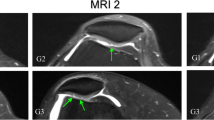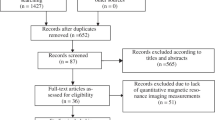Abstract
Purpose
The purpose of this study was to investigate the effect of a 6-month period of intensive running followed by the participation at a marathon run on cartilage volume and thickness in knees of marathon beginners.
Methods
Ten asymptomatic marathon beginners underwent a supervised 6-month training program, which was finalized by the participation at a marathon run. Three-dimensional quantitative magnetic resonance imaging was performed before the training program (baseline measurements) and 1 day after the marathon (follow-up measurements). Cartilage volume and thickness of the medial and lateral femur, medial and lateral tibia, and patella were measured using semiautomated cartilage segmentation and three dimensional data postprocessing.
Results
Significant differences between baseline and follow-up measurements were observed at the lateral femur, where cartilage volume and thickness decreased by a mean of 3.2 ± 3.0 % (p = 0.012) and 1.7 ± 1.6 % (p = 0.010), respectively. No significant changes in cartilage volume and thickness were observed at the medial and lateral tibia, the medial femur, and the patella.
Conclusion
Significant cartilage loss was observed at the lateral femur; however, the measured values are comparable to previously reported precision errors for quantitative cartilage measurement and thus most likely not of clinical relevance. High-impact forces during long-distance running are well tolerated even in marathon beginners and do not lead to clinical relevant cartilage loss.
Level of evidence
IV.



Similar content being viewed by others
References
Boocock M, McNair P, Cicuttini F, Stuart A, Sinclair T (2009) The short-term effects of running on the deformation of knee articular cartilage and its relationship to biomechanical loads at the knee. Osteoarthr Cartil 17(7):883–890
Burgkart R, Glaser C, Hinterwimmer S, Hudelmaier M, Englmeier KH, Reiser M, Eckstein F (2003) Feasibility of T and Z scores from magnetic resonance imaging data for quantification of cartilage loss in osteoarthritis. Arthritis Rheum 48(10):2829–2835
Burgkart R, Glaser C, Hyhlik-Durr A, Englmeier KH, Reiser M, Eckstein F (2001) Magnetic resonance imaging-based assessment of cartilage loss in severe osteoarthritis: accuracy, precision, and diagnostic value. Arthritis Rheum 44(9):2072–2077
Caselli MA, Longobardi SJ (1997) Lower extremity injuries at the New York City Marathon. J Am Podiatr Med Assoc 87(1):34–37
Chakravarty EF, Hubert HB, Lingala VB, Zatarain E, Fries JF (2008) Long distance running and knee osteoarthritis. A prospective study. Am J Prev Med 35(2):133–138
Conaghan PG (2002) Update on osteoarthritis part 1: current concepts and the relation to exercise. Br J Sports Med 36(5):330–333
Cymet TC, Sinkov V (2006) Does long-distance running cause osteoarthritis? J Am Osteopath Assoc 106(6):342–345
Eckstein F, Heudorfer L, Faber SC, Burgkart R, Englmeier KH, Reiser M (2002) Long-term and resegmentation precision of quantitative cartilage MR imaging (qMRI). Osteoarthr Cartil 10(12):922–928
Eckstein F, Hudelmaier M, Putz R (2006) The effects of exercise on human articular cartilage. J Anat 208(4):491–512
Eckstein F, Reiser M, Englmeier KH, Putz R (2001) In vivo morphometry and functional analysis of human articular cartilage with quantitative magnetic resonance imaging–from image to data, from data to theory. Anat Embryol (Berl) 203(3):147–173
Eckstein F, Westhoff J, Sittek H, Maag KP, Haubner M, Faber S, Englmeier KH, Reiser M (1998) In vivo reproducibility of three-dimensional cartilage volume and thickness measurements with MR imaging. AJR Am J Roentgenol 170(3):593–597
Fredericson M, Misra AK (2007) Epidemiology and aetiology of marathon running injuries. Sports Med 37(4–5):437–439
Glaser C, Burgkart R, Kutschera A, Englmeier KH, Reiser M, Eckstein F (2003) Femoro-tibial cartilage metrics from coronal MR image data: technique, test-retest reproducibility, and findings in osteoarthritis. Magn Reson Med 50(6):1229–1236
Glaser C, Faber S, Eckstein F, Fischer H, Springer V, Heudorfer L, Stammberger T, Englmeier KH, Reiser M (2001) Optimization and validation of a rapid high-resolution T1-w 3D FLASH water excitation MRI sequence for the quantitative assessment of articular cartilage volume and thickness. Magn Reson Imaging 19(2):177–185
Graichen H, Jakob J, von Eisenhart-Rothe R, Englmeier KH, Reiser M, Eckstein F (2003) Validation of cartilage volume and thickness measurements in the human shoulder with quantitative magnetic resonance imaging. Osteoarthr Cartil 11(7):475–482
Graichen H, Springer V, Flaman T, Stammberger T, Glaser C, Englmeier KH, Reiser M, Eckstein F (2000) Validation of high-resolution water-excitation magnetic resonance imaging for quantitative assessment of thin cartilage layers. Osteoarthr Cartil 8(2):106–114
Graichen H, von Eisenhart-Rothe R, Vogl T, Englmeier KH, Eckstein F (2004) Quantitative assessment of cartilage status in osteoarthritis by quantitative magnetic resonance imaging: technical validation for use in analysis of cartilage volume and further morphologic parameters. Arthritis Rheum 50(3):811–816
Hinterwimmer S, Krammer M, Krotz M, Glaser C, Baumgart R, Reiser M, Eckstein F (2004) Cartilage atrophy in the knees of patients after seven weeks of partial load bearing. Arthritis Rheum 50(8):2516–2520
Hohmann E, Wortler K, Imhoff AB (2004) MR imaging of the hip and knee before and after marathon running. Am J Sports Med 32(1):55–59
Hyhlik-Durr A, Faber S, Burgkart R, Stammberger T, Maag KP, Englmeier KH, Reiser M, Eckstein F (2000) Precision of tibial cartilage morphometry with a coronal water-excitation MR sequence. Eur Radiol 10(2):297–303
Kavanagh T (1984) Distance running and cardiac rehabilitation: physiologic and psychosocial considerations. Clin Sports Med 3(2):513–526
Kessler MA, Glaser C, Tittel S, Reiser M, Imhoff AB (2006) Volume changes in the menisci and articular cartilage of runners: an in vivo investigation based on 3-D magnetic resonance imaging. Am J Sports Med 34(5):832–836
Kessler MA, Glaser C, Tittel S, Reiser M, Imhoff AB (2008) Recovery of the menisci and articular cartilage of runners after cessation of exercise: additional aspects of in vivo investigation based on 3-dimensional magnetic resonance imaging. Am J Sports Med 36(5):966–970
Konradsen L, Hansen EM, Sondergaard L (1990) Long distance running and osteoarthrosis. Am J Sports Med 18(4):379–381
Krampla W, Mayrhofer R, Malcher J, Kristen KH, Urban M, Hruby W (2001) MR imaging of the knee in marathon runners before and after competition. Skelet Radiol 30(2):72–76
Krampla WW, Newrkla SP, Kroener AH, Hruby WF (2008) Changes on magnetic resonance tomography in the knee joints of marathon runners: a 10-year longitudinal study. Skeletal Radiol 37(7):619–626
Kretsch A, Grogan R, Duras P, Allen F, Sumner J, Gillam I (1984) 1980 Melbourne marathon study. Med J Aust 141(12–13):809–814
Kunz M, Williams A, McKenzie C, Burstein D, Eckstein F (2005) No prolonged deformation of knee joint cartilage after the Boston marathon. Osteoarthr Cartil 13(Suppl 1):124
Kursunoglu-Brahme S, Schwaighofer B, Gundry C, Ho C, Resnick D (1990) Jogging causes acute changes in the knee joint: an MR study in normal volunteers. AJR Am J Roentgenol 154(6):1233–1235
Lane NE, Bloch DA, Wood PD, Fries JF (1987) Aging, long-distance running, and the development of musculoskeletal disability. A controlled study. Am J Med 82(4):772–780
Lane NE, Michel B, Bjorkengren A, Oehlert J, Shi H, Bloch DA, Fries JF (1993) The risk of osteoarthritis with running and aging: a 5 years longitudinal study. J Rheumatol 20(3):461–468
Leiter JR, MacDonald L, McRae S, Davidson M, MacDonald PB (2012) Intrinsic stresses on bone and cartilage in the normal and anterior cruciate ligament-reconstructed knee before and after a half marathon: a magnetic resonance imaging analysis. Clin J Sport Med 22(5):439–442
Luke AC, Stehling C, Stahl R, Li X, Kay T, Takamoto S, Ma B, Majumdar S, Link T (2010) High-field magnetic resonance imaging assessment of articular cartilage before and after marathon running: does long-distance running lead to cartilage damage? Am J Sports Med 38(11):2273–2280
Mosher TJ, Liu Y, Torok CM (2010) Functional cartilage MRI T2 mapping: evaluating the effect of age and training on knee cartilage response to running. Osteoarthr Cartil 18(3):358–364
Mosher TJ, Smith HE, Collins C, Liu Y, Hancy J, Dardzinski BJ, Smith MB (2005) Change in knee cartilage T2 at MR imaging after running: a feasibility study. Radiology 234(1):245–249
Muhlbauer R, Lukasz TS, Faber TS, Stammberger T, Eckstein F (2000) Comparison of knee joint cartilage thickness in triathletes and physically inactive volunteers based on magnetic resonance imaging and three-dimensional analysis. Am J Sports Med 28(4):541–546
Panush RS, Hanson CS, Caldwell JR, Longley S, Stork J, Thoburn R (1995) Is running associated with osteoarthritis? an 8 years follow-up study. J Clin Rheumatol 1(1):35–39
Panush RS, Schmidt C, Caldwell JR, Edwards NL, Longley S, Yonker R, Webster E, Nauman J, Stork J, Pettersson H (1986) Is running associated with degenerative joint disease? JAMA 255(9):1152–1154
Powell KE, Paffenbarger RS Jr (1985) Workshop on epidemiologic and public health aspects of physical activity and exercise: a summary. Public Health Rep 100(2):118–126
Satterthwaite P, Larmer P, Gardiner J, Norton R (1996) Incidence of injuries and other health problems in the Auckland Citibank marathon, 1993. Br J Sports Med 30(4):324–326
Satterthwaite P, Norton R, Larmer P, Robinson E (1999) Risk factors for injuries and other health problems sustained in a marathon. Br J Sports Med 33(1):22–26
Schueller-Weidekamm C, Schueller G, Uffmann M, Bader TR (2006) Does marathon running cause acute lesions of the knee? evaluation with magnetic resonance imaging. Eur Radiol 16(10):2179–2185
Shellock FG, Deutsch AL, Mink JH, Kerr R (1991) Do asymptomatic marathon runners have an increased prevalence of meniscal abnormalities? an MR study of the knee in 23 volunteers. AJR Am J Roentgenol 157(6):1239–1241
Shellock FG, Mink JH (1991) Knees of trained long-distance runners: MR imaging before and after competition. Radiology 179(3):635–637
Shellock FG, Morris E, Deutsch AL, Mink JH, Kerr R, Boden SD (1992) Hematopoietic bone marrow hyperplasia: high prevalence on MR images of the knee in asymptomatic marathon runners. AJR Am J Roentgenol 158(2):335–338
Smith TO, Drew BT, Toms AP, Donell ST, Hing CB (2012) Accuracy of magnetic resonance imaging, magnetic resonance arthrography and computed tomography for the detection of chondral lesions of the knee. Knee Surg Sports Traumatol Arthrosc 20(12):2367–2379
Sohn RS, Micheli LJ (1985) The effect of running on the pathogenesis of osteoarthritis of the hips and knees. Clin Orthop Relat Res 198:106–109
Stahl R, Luke A, Ma CB, Krug R, Steinbach L, Majumdar S, Link TM (2008) Prevalence of pathologic findings in asymptomatic knees of marathon runners before and after a competition in comparison with physically active subjects—a 3.0 T magnetic resonance imaging study. Skelet Radiol 37(7):627–638
Stammberger T, Eckstein F, Englmeier KH, Reiser M (1999) Determination of 3D cartilage thickness data from MR imaging: computational method and reproducibility in the living. Magn Reson Med 41(3):529–536
Stammberger T, Eckstein F, Michaelis M, Englmeier KH, Reiser M (1999) Interobserver reproducibility of quantitative cartilage measurements: comparison of B-spline snakes and manual segmentation. Magn Reson Imaging 17(7):1033–1042
Vanwanseele B, Eckstein F, Knecht H, Stussi E, Spaepen A (2002) Knee cartilage of spinal cord-injured patients displays progressive thinning in the absence of normal joint loading and movement. Arthritis Rheum 46(8):2073–2078
Williams PT (1997) Interactive effects of exercise, alcohol, and vegetarian diet on coronary artery disease risk factors in 9242 runners: the National Runners’ Health Study. Am J Clin Nutr 66(5):1197–1206
Willick SE, Hansen PA Running and osteoarthritis. Clin Sports Med 29 (3):417–428
Wong M, Carter DR (2003) Articular cartilage functional histomorphology and mechanobiology: a research perspective. Bone 33(1):1–13
Author information
Authors and Affiliations
Corresponding author
Additional information
Stefan Hinterwimmer and Matthias J. Feucht have contributed equally to this work and share first authorship.
Rights and permissions
About this article
Cite this article
Hinterwimmer, S., Feucht, M.J., Steinbrech, C. et al. The effect of a six-month training program followed by a marathon run on knee joint cartilage volume and thickness in marathon beginners. Knee Surg Sports Traumatol Arthrosc 22, 1353–1359 (2014). https://doi.org/10.1007/s00167-013-2686-6
Received:
Accepted:
Published:
Issue Date:
DOI: https://doi.org/10.1007/s00167-013-2686-6




